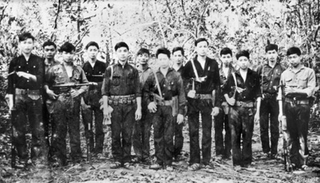
The 4th Battalion, Royal Australian Regiment was an infantry battalion of the Australian Army, forming part of the Royal Australian Regiment and eventually Special Operations Command. The battalion was formed on 1 February 1964, converted to a special forces unit on 1 February 1997, and was renamed the 2nd Commando Regiment on 19 June 2009.

6th Battalion, Royal Australian Regiment is a mechanised infantry battalion of the Australian Army. It was originally raised in Brisbane, Queensland, on 6 June 1965 and has since then served in a number of overseas deployments and conflicts including South Vietnam, East Timor, Iraq and Afghanistan. During the Vietnam War, the battalion earned a US Presidential Unit Citation from the United States when members from 'D' Company participated in the Battle of Long Tan on 18–19 August 1966. The battalion is currently based at Gallipoli Barracks in Brisbane and forms part of the 7th Brigade.

The 1st Australian Task Force was a brigade-sized formation which commanded Australian and New Zealand Army units deployed to South Vietnam between 1966 and 1972. 1 ATF was based in a rubber plantation at Nui Dat, 8 kilometres (5.0 mi) north of Bà Rịa in Phuoc Tuy Province and consisted of two and later three infantry battalions, with armour, aviation, engineers and artillery support. While the task force was primarily responsible for securing Phuoc Tuy Province, its units, and the Task Force Headquarters itself, occasionally deployed outside its Tactical Area of Responsibility.

The 3rd Battalion, Royal Australian Regiment is a mechanised infantry battalion of the Australian Army, based in Kapyong Lines, Townsville as part of the 3rd Brigade. 3 RAR traces its lineage to 1945 and has seen operational service in Japan, Korea, Malaya, Borneo, South Vietnam, Rifle Company Butterworth, East Timor, the Solomon Islands, Afghanistan and Iraq.

The Battle of Coral–Balmoral was a series of actions fought during the Vietnam War between the 1st Australian Task Force and the North Vietnamese People's Army of Vietnam (PAVN) 7th Division and Viet Cong (VC) Main Force units, 40 kilometres (25 mi) north-east of Saigon. Following the defeat of the PAVN/VC Tet offensive in January and February, in late April two Australian infantry battalions—the 1st and 3rd Battalions of the Royal Australian Regiment (RAR)—with supporting arms, were again deployed from their base at Nui Dat in Phước Tuy Province to positions astride infiltration routes leading to Saigon to interdict renewed movement against the capital. Part of the wider allied Operation Toan Thang I, it was launched in response to intelligence reports of another impending PAVN/VC offensive, yet the Australians experienced little fighting during this period. Meanwhile, the PAVN/VC successfully penetrated the capital on 5 May, plunging Saigon into chaos during the May Offensive in an attempt to influence the upcoming Paris peace talks scheduled to begin on the 13th. During three days of intense fighting the attacks were repelled by US and South Vietnamese forces, and although another attack was launched by the PAVN/VC several days later, the offensive was again defeated with significant losses on both sides, causing extensive damage to Saigon and many civilian casualties. By 12 May the fighting was over, and the PAVN/VC were forced to withdraw having suffered heavy casualties. US casualties were also heavy and it proved to be their most costly week of the war.

The 2nd Battalion, Royal Australian Regiment is an amphibious light infantry battalion of the Australian Army part of the 1st Division Amphibious Task Group based at Lavarack Barracks in Townsville.

The 5th Battalion, Royal Australian Regiment is a regular motorised infantry battalion of the Australian Army. Originally established in 1965 it would serve two tours of South Vietnam before it was linked with the 7th Battalion to form the 5th/7th Battalion, Royal Australian Regiment in 1973. In late 2006 the two units were de-linked, and 5 RAR again joined the Australian Army's order of battle in its own right. It has since served in Iraq, East Timor and Afghanistan.

The 7th Battalion, Royal Australian Regiment is a regular infantry battalion of the Australian Army. It was originally raised in 1965 as part of Australia's commitment to the Vietnam War and it eventually served two tours in Vietnam in 1967 and 1971. In 1973, following Australia's withdrawal from the conflict, the battalion was amalgamated with the 5th Battalion, Royal Australian Regiment to form the 5th/7th Battalion, Royal Australian Regiment.

The Battle of Binh Ba, also known as Operation Hammer, took place during the Vietnam War. The action occurred when Australian Army troops from the 5th Battalion, Royal Australian Regiment fought a combined force of People's Army of Vietnam (PAVN) and Viet Cong (VC), including a company from the PAVN 33rd Regiment and elements of the VC D440 Battalion, in the village of Bình Ba, 5 kilometres (3.1 mi) north of Nui Dat in Phuoc Tuy Province. The battle was unusual in Australian combat experience in South Vietnam as it involved fierce close-quarter house-to-house fighting, although the majority of enemy killed was through heavy artillery and air-bombardment. In response to PAVN/VC attempts to capture Binh Ba the Australians assaulted the village with infantry, armour and helicopter gunships, routing the VC and largely destroying the village itself. Such battles were not the norm in Phuoc Tuy, however, and the heavy losses suffered by the PAVN/VC forced them to temporarily leave the province. Although the Australians did encounter PAVN/VC Main Force units in the years to come, the battle marked the end of such large-scale clashes, and ranks as one of the major Australian victories of the war.

The 8th Battalion, Royal Australian Regiment was an Australian Army Regular infantry battalion. The battalion was formed in July 1966 as part of an expansion of the Australian Army in the mid-1960s due to the perceived threat of Communism in southeast Asia. Initially the battalion was sent to Malaysia in 1967, before later being sent to South Vietnam as part of Australia's commitment to the Vietnam War. Between November 1969 and October 1970 the battalion undertook operations as part of the 1st Australian Task Force, before being brought back to Australia. In October 1973, after Australia's involvement in Vietnam officially ended, the battalion was amalgamated with 9 RAR to form 8/9 RAR.

The 1st Armoured Personnel Carrier Squadron was an armoured unit of the Australian Army raised for service during the Vietnam War. Raised in 1965, the unit was deployed to South Vietnam in May 1966 to join the 1st Australian Task Force. After that 1 APC Sqn was involved in numerous operations in support of the 5th and 6th Battalions, the Royal Australian Regiment, with the most notable action coming on 18 August 1966 when the squadron was involved in the Battle of Long Tan. In January 1967, 1 APC Sqn was redesignated as 'A' Squadron, 3rd Cavalry Regiment.

Operation Coburg was an Australian and New Zealand military action during the Vietnam War. The operation saw heavy fighting between the 1st Australian Task Force and North Vietnamese People's Army of Vietnam (PAVN) and Viet Cong (VC) forces during the wider fighting around Long Binh and Bien Hoa.

The Battle of Long Khanh was fought during the Vietnam War between elements of 1st Australian Task Force and the Viet Cong (VC) and People's Army of Vietnam (PAVN) during Operation Overlord. The fighting saw Australian infantry from 3rd Battalion, Royal Australian Regiment attack a heavily fortified communist base camp in Long Khanh Province, while Centurion tanks providing close support crushed many bunkers and their occupants. Regardless, the VC fought hard to delay the Australian advance and although the bunker system was subsequently captured, along with a second system further south, the Australians suffered a number of casualties and the loss of a UH-1 Iroquois helicopter. With the Australians unable to concentrate sufficient combat power to achieve a decisive result, the bulk of the VC/PAVN force successfully withdrew intact, although they probably sustained heavy casualties in the process.

The Battle of Hat Dich was a series of military actions fought between an allied contingent, including the 1st Australian Task Force and the People's Army of Vietnam (PAVN) and Viet Cong (VC) during the Vietnam War. Under the code name Operation Goodwood, two battalions from 1 ATF deployed away from their base in Phước Tuy Province, operating against suspected PAVN/VC bases in the Hat Dich area, in western Phước Tuy, south-eastern Biên Hòa and south-western Long Khánh provinces as part of a large allied sweep known as Operation Toan Thang II. The Australians and New Zealanders conducted sustained patrolling throughout the Hat Dich and extensively ambushed tracks and river systems in the Rung Sat Special Zone, occupying a series of fire support bases as operations expanded. Meanwhile, American, South Vietnamese and Thai forces also operated in direct support of the Australians as part of the division-sized action.

Hát Dịch secret zone was an area within South Vietnam. It covered the area where the borders of Phước Tuy, Long Khánh and Biên Hòa Provinces met.

The 445th Battalion, also known as the D445 Provincial Mobile Battalion or the Ba Ria Battalion, was a local force battalion of the Viet Cong (VC) during the Vietnam War.
The Battle of Núi Lé was the last major battle fought by Australian and New Zealand forces in South Vietnam. The battle was fought in the former Phước Tuy Province between elements of the People's Army of Vietnam (PAVN) 33rd Regiment and 4RAR/NZ (ANZAC) Battalion during Operation Ivanhoe. Núi Lé, a small hill within Quang Thanh commune in Chau Duc District, is today in Ba Ria-Vung Tau Province.

The 1st Australian Civil Affairs Unit was raised in 1967 to coordinate the Australian Army's contribution to the US and allied Pacification Program during the Vietnam War, operating in Phuoc Tuy Province. Although other Australian units also conducted civic action projects in South Vietnam at various times, 1 ACAU had the primary responsibility for them once it was deployed. It was withdrawn from South Vietnam in November 1971.

Operation Hardihood was a security operation conducted from 16 May to 8 June 1966 during the Vietnam War by the U.S. 503rd Infantry Regiment, the 1st Battalion, Royal Australian Regiment (1RAR) and the 5th Battalion, Royal Australian Regiment in Phước Tuy Province, South Vietnam to secure the area around Nui Dat for the establishment of a base area for the 1st Australian Task Force.
The Royal New Zealand Infantry Regiment contributed companies to the 1st Australian Task Force, deployed in Phước Tuy Province, Republic of Vietnam during the Vietnam War from 1967-1972.



















